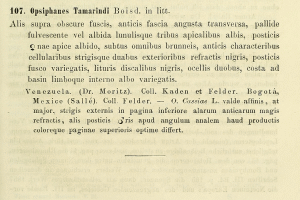

 +19Kontinente:EUMASAOC
+19Kontinente:EUMASAOC3. Biologie
3.1. Nahrung der Raupe
- [Musaceae:] Musa x paradisiaca (Banane)
Die Raupe lebt an Blättern von Bananen und wird als Puppe immer wieder einmal verschleppt.
4. Weitere Informationen
4.1. Faunistik
Bristow (1986: 96) trägt die ihm bekannt gewordenen Daten aus Großbritannien zusammen und erläutert: „Opsiphanes tamarindi is a large […] polytypic, neotropical species of the Satyrid subfamily brassolinae, with a range from Mexico to southern Peru. The larval foodplants commonly include banana, and the larvae sometimes occur in sufficient numbers to be a serious pest. It is not surprising therefore that tamarindi occasionally occurs as an accidental import with bananas. To date, I know of five records for Britain: Eastbourne (Andrews, 1931), London (Thomson, 1937), Edinburgh in 1978 Glasgow in 1979 (Thomson, 1980) and Ramsey Market in 1981 (from Belize, J. Heath, pers. comm.), as well as one for Rotterdam, Holland (from Colombia, Jurriaanse, 1923) and nine from New Zealand (from Ecuador, A. Harris, pers. comm.).” Agassiz et al. (2013: 112) führen die Art bei den "adventive species" und schreiben zu England und Schottland: "At least seven specimens 1931-1984: (Bristow 1986; Bristow, 2011). Central and South American."
Vives-Moreno (2014) kann auf einen neueren Einzelfund aus Spanien hinweisen: „Especie eminentemente americana ha sido indicada de Tarragona, originario de Costa Rica. Es importande estudiar eta especie y verificar si se produce su establecimiento en España, antes de considerarla como presente en nuestra fauna (PÉREZ DE-GREGORIO et al., 2011).” Bei Perez De-Gregorio et al. (2011) wird unter der Überschrift “Opsiphanes tamarindi (Felder & Felder, 1861), un nou lepidòpter exòtic trobat al port de Tarragona (Catalunya) (Lepidoptera: Brassolidae)” über diesen Nachweis eines verschleppten Falters am 21. September 2010 im Hafen von Tarragona berichtet. Bisher gibt es keinerlei Hinweis auf eine mögliche Etablierung in Europa i.w.S.
(Autor: Erwin Rennwald)
Nach [Global Biodiversity Information Facility] kommt die Art in Mexiko, Costa Rica, Kolumbien, Nicaragua, Peru, Ecuador, Belize, Bolivien, Brasilien, Panama, Guatemala, Honduras, Venezuela, Spanien?, Französisch-Guayana und El Salvador vor.
Locus typicus gemäß Erstbeschreibung: Venezuela, Mexico.
(Autor: Michel Kettner)
4.2. Literatur
- Agassiz, D.J.L., Beavan, S.D. & R.J. Heckford (2013): Checklist of the Lepidoptera of the British Isles. - Royal Entomological Society. 206pp.
- Bristow (1986): The occurence of Opsiphanes tamarindi Felder & Felder (Lepidoptera: Satyridae) in Britain. — Entomologist’s record and journal of variation, 98: 96-97. [Digitalisat auf biodiversitylibrary.org]
- Erstbeschreibung: Felder & Felder (1861): Lepidoptera novae Columbiae, diagnosibus collustrata a C. & C. et R. Felder. Series secunda (1861): Wiener entomologische Monatschrift 5 (4): 97-111. [PDF auf zobodat.at]
- Pérez De-Gregorio, J.J., Romañá Ferrer-Vidal, I., Rondós Casas, M. & M. Nel·lo (2011): Opsiphanes tamarindi (Felder & Felder, 1861), un nou lepidòpter exòtic trobat al port de Tarragona (Catalunya) (Lepidoptera: Brassolidae). Opsiphanes tamarindi (Felder & Felder, 1861), a new exotic butterfly found in the Port of Tarragona (Catalonia) (Lepidoptera: Brassolidae). — Bolletí de la Societat Catalana de Lepidopterologia, 102: 106. [PDF auf ichn2.iec.cat]
- Vives-Moreno (2014): Catálogo sistemático y sinonímico de los Lepidoptera de la Península Ibérica, de Ceuta, de Melilla y de las Islas Azores, Baleares, Canarias, Madeira y Salvajes (Insecta: Lepidoptera). — Suplemento de SHILAP Revista de Lepidopterología: 1-1184. Madrid.






















